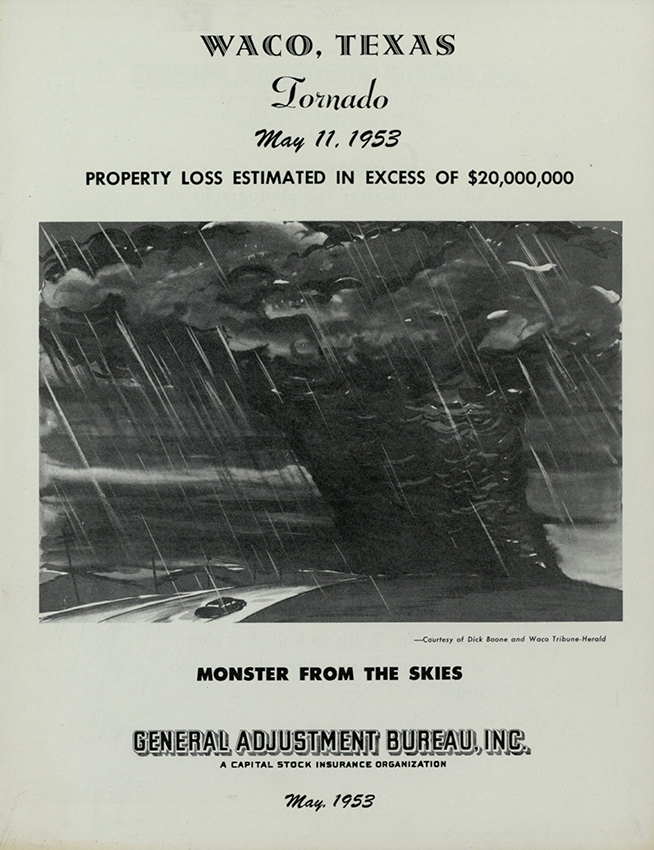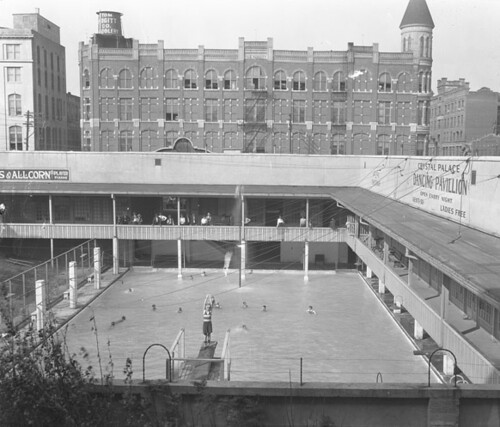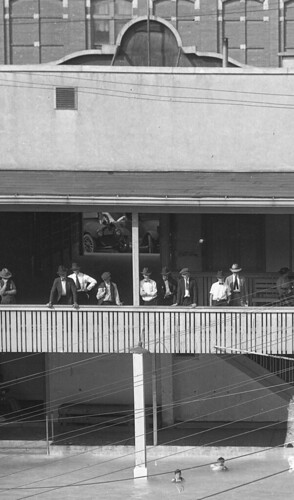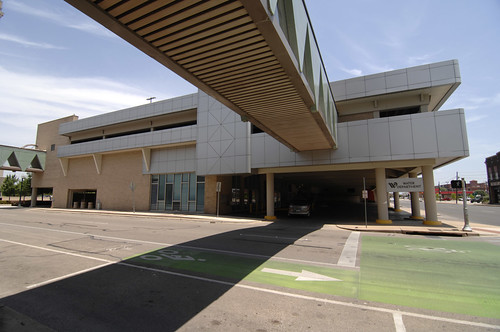Each month, we post an update to notify our readers about the latest archival collections to be processed and some highlights of our print material acquisitions. These resources are primed for research and are just a sampling of the many resources to be found at The Texas Collection!Continue Reading
Amicable Alico Building
Research Ready: December 2017
Each month, we post an update to notify our readers about the latest archival collections to be processed and some highlights of our print material acquisitions. These resources are primed for research and are just a sampling of the many resources to be found at The Texas Collection!
December’s finding aids
By Paul Fisher, Processing Archivist
-

Letter from Charles Wellborn, student at Baylor and future evangelist and pastor, to the Armed Services Representative for Baylor University. In the letter, Wellborn describes drilling for the past week, after enlisting in the United States Army in July 1943. - BU Records: Armed Services Representatives, 1942-1945, undated (#BU/12): Collection contains correspondence sent by former students, parents, and government officials to Merle Mears McClellan, Baylor University’s Armed Services Representative during World War II. Baylor President Pat Neff appointed McClellan as the acting liason between the university and the military, in conjunction with Baylor University becoming a training site for Army officers prior to World War II.
December’s print materials
By Amie Oliver, Librarian and Curator of Print Materials
Texas over Time: Austin Avenue from City Hall, Waco
Texas has changed quite a bit over the years, as is readily seen in our vast photograph and postcard collections. To help bring some of those changes to life, we’ve created a “Texas over Time” series of GIFs that will illustrate the construction and renovations of buildings, changing aerial views, and more. Our collections are especially strong on Waco and Baylor images, but look for some views beyond the Heart of Texas, too.
 Our readers may remember that we did a GIF of Waco’s Austin Avenue awhile back, looking at City Hall. Now, we look the other direction! A few facts about the buildings/businesses you see in this GIF…
Our readers may remember that we did a GIF of Waco’s Austin Avenue awhile back, looking at City Hall. Now, we look the other direction! A few facts about the buildings/businesses you see in this GIF…
- ALICO Building: Construction for the Amicable (ALICO) Building began in 1910 and after a height competition with the Adolphus Hotel in Dallas, it was decided that the building would be 22-stories high. The builders, Sanguinet and Staats of Forth Worth and Roy E. Lane of Waco, wanted the building to have a structure that could sustain disaster, so a steel frame was put into place, and this was proved worthwhile after the 1953 tornado. The Texas State Historical Commission named the ALICO building a historical landmark in 1982.
- Roosevelt Hotel: Before it became the Roosevelt Hotel, local civic leader Peter McClelland built the McClelland Hotel in 1872. The property was purchased by Conrad Hilton of the international chain, Hilton Hotels and Resorts. The economic downturn of the Great Depression caused Hilton to sell the property in 1934 to local investors, where it finally became known as the Roosevelt Hotel, honoring President Franklin D. Roosevelt. The Roosevelt was one of the three buildings in the storm’s path that stood strong during the 1953 Waco tornado. Its steel frame supported the structure but for the businesses that did not survive, the owners relocated to the suburbs and the Roosevelt Hotel was forced to close in 1961. After its life as the Regis Retirement Home, local builder Mike Clark bought the building in 2004 and the space was renovated to accommodate event rentals, restaurants, and offices.
- W.P. Pipkin Drugs: One of the Southwest’s largest independently owned drugstore chains, the W.P. Pipkin Drug store was successfully run by William Pipkin and then after his death, it was run by his daughter, Pauline Pipkin Garrett. Pipkin was the first drugstore owner to hire women and in a time where opportunities for women were limited, Garrett exceeded these expectations by expanding her father’s business into a thriving enterprise throughout Waco. Pipkin Drugs had seven locations.
- Sanger Bros./Montgomery Ward: The Sanger Brothers open their shoe store on the square between Austin Avenue and Bankers’ Alley on March 4, 1873. Their store later moved between Fourth and Fifth Street on Austin Avenue. Products the store sold included “dry goods, clothing, boots, shoes, hats, caps, gents’ furnishing goods, carpets, and oil cloths,” per an ad by the Waco Daily Examiner. The business was very successful up until Sam Sanger’s death in 1919. In its final days thousands of dedicated customers were reported to show up for the last sales.
Bibliography
Kyle Baughman and Amanda Sawyer, “Amicable (ALICO) Building,” Waco History, accessed October 9, 2015, http://wacohistory.org/items/show/23.
Geoff Hunt, “Pauline Pipkin Garrett,” Waco History, accessed October 9, 2015, ffghttp://wacohistory.org/items/show/101.
Amanda Sawyer, “Sanger Brothers Department Store,” Waco History, accessed October 9, 2015, http://wacohistory.org/items/show/85.
Amanda Sawyer, “Roosevelt Hotel,” Waco History, accessed November 4, 2015, http://wacohistory.org/items/show/41.
GIF and factoids by Haley Rodriguez, archives student assistant. See these and other images of Austin Avenue in our Flickr set.
1966: The Year Waco’s ALICO Building Meets Mid-Century
By Geoff Hunt, Audio and Visual Curator

Between 1958 and 1978, Waco underwent major changes through the federally funded Urban Renewal Agency of Waco. Areas impacted included numerous city blocks between LaSalle Avenue and Waco Drive. The project greatly affected the city’s people, businesses, schools, and buildings.
Between 1964 and 1966, the city’s landmark ALICO (American Life Insurance Company) Building received major updates as well. The largest and most significant addition to the structure was the ALICO Inn and its convention facilities. The 22-story ALICO Building, originally known as the Amicable Building, was completed in 1911, and designed by architects Roy E. Lane and Sanguinet & Staats. When built, it was the tallest office building in the southwestern United States. Its location was once in the city’s central business district, and it was a vital part of the city’s economy. To remain that way, it needed to keep pace with the rapidly changing business climate of Waco in the 1950s and ’60s.

With the closing of the Roosevelt Hotel and its conversion into a retirement facility, more downtown hotels were needed, and the Waco Chamber of Commerce was receptive to ideas like the creation of the ALICO Center. The city wanted to attract conventions and shoppers to the downtown area. The center’s proposal was initiated by 29-year-old architect Jay Frank Powell, owner of Down-Tel Corp., a company specializing in building motels in downtown areas. According to the September 20, 1964, Waco Tribune-Herald, the Waco Chamber, when presented with the ALICO Center plan: “pounced on Powell like a piece of beef dangled before a starving lion.”

When completed in 1966, the ALICO Center Inn contained 115 rooms for overnight guests, a second-floor meeting room that would seat 250 in a banquet or 1,000 to 1,200 people auditorium-style. It was described as a “downtown motor hotel with convention facilities, a motor bank and a five-story parking garage.” The ALICO Center was designed to match its changing surroundings, including part of Austin Avenue’s closure to make it into a pedestrian mall, another part of the Waco Urban Renewal Agency’s planning. [Check out our blog post on that subject.]
At the 1964 ALICO Center groundbreaking ceremony, the president of the Amicable Life Insurance Company, Franklin Smith, stated, “it will be not only a step toward completion of ALICO Center, but mark the beginning of a new atmosphere and a new enthusiasm in downtown Waco.” Additionally, Waco’s then mayor, Roger Conger, compared the event “to the historic groundbreaking for the Amicable Building more than 50 years ago.”

The end result, completed in 1966, changed the design of the original 1911 ALICO Building, with the new hotel, convention center, parking garage, and motor bank, joined directly to it. As a result, the ALICO Center’s additions took up nearly the entire 400 block of Austin Avenue—stretching much of the complex back to Washington Avenue. Overall, it was impressive and imposing—different in every aspect of what that side of the 400 block of Austin Avenue looked like before. The entire redesign of the 1966 ALICO Center seemed well balanced in appearance—and represented the mid-century architectural style frequently seen during the period.
However, the ALICO Center as it appeared in 1966 is no longer. The hotel and convention center were demolished in about 1998, and the space is now used as a parking lot. The main vintage 1911 building and parking garage complex remain, and retain most of the later modifications. This includes much of the 1966 addition’s facade at street level, wrapping around Austin Avenue, the parking garage along 5th Street, and back to the Washington Avenue side of the complex.

In spring 2016, it will be fifty years since the ALICO Center opened for operations. The main building is now 104 years old. The structure has, and remains successful and its exterior is a mixture of old and “new.” Most importantly, it continues to be Waco’s most prominent downtown landmark.
Occupiers of the Inn and Conference Center at 411 Austin Avenue, according to Waco Polk City Directories include:
*ALICO Inn: 1966-1970
*Hilton Inn: 1970-1971
*Waco Plaza Motel: 1972-1978
*Brazos Inn: 1979-1982
*Rodeway Inn: 1983-1984
*Brazos Inn: 1985-1991
*Brittney Hotel: 1992-1994
*Vacant: 1995-1997
*Mark Domangue and Associates Security Brokers: 1998
*Building demolished around this time period-disappears from the records: 1999
See more images of the different looks of the ALICO building over time in our Flickr set.
Created with flickr slideshow.
Sources
“Architect Will Reach Goal In Building of ALICO Center,” The Waco Tribune-Herald (Waco, TX.), Sep. 20, 1964.
“New Era Seen as Work Begins on Huge Motel,” The Waco News-Tribune (Waco, TX.), Dec. 8, 1964.
“ALICO Keeps Pace with Time,” The Baylor Lariat (Waco, TX.), Feb 26, 1966.
“Charles Hunton-Hilton Inn Manager,” The Waco Citizen (Waco, TX.), Nov. 20, 1969.
“Conventions at Brazos,” The Waco Citizen (Waco, TX.), Mar. 10, 1981.
“Rodeway Now Brazos Inn,” The Waco Citizen (Waco, TX.), Feb. 19, 1985.
Texas over Time: ALICO building, Waco
Texas has changed quite a bit over the years, as is readily seen in our vast photograph collection. To help bring some of those changes to life, we’ve created a “Texas over Time” series of GIFs that will illustrate the construction and renovations of buildings, changing aerial views, and more. Our collections are especially strong on Waco and Baylor images, but look for some views beyond the Heart of Texas, too.
 Construction photos by Gildersleeve, 1911; modern photo (photographer unknown), 1984
Construction photos by Gildersleeve, 1911; modern photo (photographer unknown), 1984
- The ALICO, now a Waco landmark, was started in 1910 and completed in 1911, by the architecture firm Sanguinet and Staats, with the help of famous architect Roy Ellsworth Lane.
- The parcel of land that the building currently sits on at the intersection of 5th and Austin Ave was home to several things before the ALICO came along. The first recorded use of the land was a small pond that served as a buffalo watering hole and fishing spot. Around the time of the Civil War, the pond had dried up, and a blacksmith shop was built by W.E. Oakes. The site was eventually home to a bank, which was present until being torn down to build the ALICO.
- At 22 stories, the building was so large that people as far away as McGregor could see its construction with binoculars. It even made it into a Ripley’s Believe it or Not comic in the 1930s. At the time of its construction, it was the first skyscraper in Texas, making it the tallest building in Texas. It held this title until the construction of the Magnolia in Dallas in 1922.
 Austin Avenue, before (early 1900s) and after (1910s) the ALICO
Austin Avenue, before (early 1900s) and after (1910s) the ALICO
- The ALICO was originally the home of and contracted by the Amicable Life Insurance Company, as well as being the home of several prominent lawyers, organizations, and various other businesses such as the Corner Drug Store (creators of Dr Pepper).
- The building weighs approximately 40 million pounds and required 2,004 freight cars worth of material to construct. The ALICO survived a direct hit by the 1953 tornado due to the wind resistant designs of Roy Lane, even though the RT Dennis building across the street was completely demolished.
Sources:
“The New Amicable Life Building.” Waco Tribune Herald 12 Sep. 1954. Print.
Ryan, Terri Jo, and Randy Fiedler. “The Story of the ALICO Building: 100 Years, 22 Stories and 1 Towering Ego.” Waco Tribune-Herald 28 Apr. 2011. Web. 21 Aug. 2014.
See all of these images (plus a couple bonus ones you won’t want to miss!) on Flickr. GIFs and factoids by Braxton Ray, archives student assistant
Texas over Time: Austin Avenue, Waco
Texas has changed quite a bit over the years, as is readily seen in our vast photograph collection. To help bring some of those changes to life, we’ve created a “Texas over Time” series of gifs that will illustrate the construction and renovations of buildings, changing aerial views, and more. Our collections are especially strong on Waco and Baylor images, but look for some views beyond the Heart of Texas, too.
 Austin Avenue: 1906, 1908, 1914, 1940s, 1950s
Austin Avenue: 1906, 1908, 1914, 1940s, 1950s
- On May 11, 1953, a F5 tornado hit downtown Waco. The damages were severe: 196 businesses and factories were destroyed, 217 sustained major damage, and 179 sustained lesser damages. Over half of the 114 people who died were in a single city block bordered by Austin and Franklin Avenues and 4th and 5th Streets. Read more here and here.
- In 1970, Austin Avenue was remodeled to serve as a pedestrian mall. It was not a success, and in 1985, the mall sidewalk was ripped up and two-way traffic was restored to downtown. One can still see remnants of the mall downtown and can feel the difference in the road going down Austin Avenue.
- The ALICO building, which was built in 1910 off Austin Avenue, was once the tallest building in the Southwest. The ALICO building is still open today and holds the headquarters for the American-Amicable Life Insurance Company of Texas and houses many other tenants.
By popular demand, here is a Flickr set of the individual images used to create this animation. We’ll include this in each future “Texas over Time” post.
Sources:
Postcards:
- Raphael Tuck and Sons’. 1906.
- The Rotograph Co. 1908.
- The Acmegraph Co. 1914.
- B-W News Agency. 1940s.
- B-W News Agency. Late 1950s.
Waco, Texas: Streets: Austin Avenue. Vertical file, The Texas Collection, Baylor University.
Gif and factoids prepared by Timothy Brestowski, student library assistant
Name of insurance company in ALICO building corrected 2/12/14.
Documenting the “Monster from the Skies”: Photographs Telling the Story of the 1953 Waco Tornado
By Geoff Hunt, Audio and Visual Curator

This week marks the 60th anniversary of the May 11, 1953, tornado that hit Waco, Texas, causing the deaths of 114 people. To honor those who lost their lives on this tragic day, and the great loss of a large part of Waco’s central business district, we have put on our Flickr page some unseen or seldom seen photographs of the affected areas of Waco, before and after this storm.
This group of images includes digitized 35mm, 4×5 and 8×10 photograph negatives, Kodachrome slides, stereo-slides, and printed photos, and features images captured by Waco photographers such as Hiram Blaine Sherrill, Randall W. Todd, Fred Marlar, and the Army Air Force Photography Division. We also included “before” photos, giving us a sense of what these stricken parts of Waco were like before the catastrophic storm.

Fred Gildersleeve, a well-known Waco photographer, also documented the storm’s wreckage. In a 1977 oral history interview, Waco historian Roger Conger remarked of Gildersleeve that “…Waco was most fortunate in having him here because he rode the crest of Waco’s remarkable development during the first twenty-five or thirty years of this century.” But sadly, just a few years prior to his death in 1958, he also saw the destruction of part of the city he had made a living photographing. He likely lost friends in the tragedy. However, like his earlier work, his documentation of the aftermath of the 1953 Waco Tornado helps to record an important part of the city’s history.

Another photographer whose work is being brought to light is Dr. Hannibal “Joe” Jaworski. He resided in the nearby Roosevelt Hotel (400 Austin Avenue) and had a medical practice on the third floor of the Amicable (ALICO) Building, on the corner of 5th and Austin. In the aftermath of the storm, he led medical care of the wounded at Waco’s Hillcrest Hospital. Jaworski previously served as a colonel in the U.S. Army Medical Corp, and so his experience earned during WWII made his contribution vital in helping those injured in this catastrophic natural disaster.

When going to some of these hard-hit areas now, all that remains are some empty lots and historical markers. However, there is nothing like a photograph taken during this time or just before to help us realize why this event was sometimes referred to as the “Monster from the Skies.”
Check out more before and after images of the 1953 Waco tornado in our Flickr slideshow. Click the arrow to make the slideshow start, and click the crosshairs in the bottom right corner to make the slideshow full-screen.
Discover more about the 1953 Waco tornado…
- Learn how The Texas Collection collaborated with the Dr Pepper Museum and other local cultural heritage organizations to commemorate the 1953 Waco tornado.
- Visit the Baylor Institute for Oral History to explore their many oral histories that discuss the tornado.
- Come research the tornado in our holdings at The Texas Collection.
- Read a blog post we wrote about the tornado last year, drawing from our archival materials.
Geyser City, Waco: Reading a Photograph of the Crystal Palace Pool

An old photo allows us to take a dip into the past…and in no image is that comparison more apt than these views of Waco’s Crystal Palace pool! Such an image almost allows you to see, hear, and feel the environment that people experienced many decades ago. By taking one photo (above, by Fred Gildersleeve, circa 1910s) and breaking it down into pieces, we can “read” so much about the former landscape of downtown Waco, Texas, and the city’s history…including one of Waco’s most cherished but now mostly vanished natural resources: artesian well water.


The Crystal Palace pool had its source of water from one of the city’s many natural artesian wells. A pipe can be seen where this natural resource freely flowed (above, left). Maybe a little too freely, as the people of Waco would learn.
The first artesian well in Waco was drilled by J.D. Bell in 1886. Bell later established the Bell Water Company and in 1904 it was sold to the city of Waco. Many more wells were drilled and consequently, Waco became known as “Geyser City.” This name was well deserved as it was recorded in 1890 that one of this city’s wells was 1,800 feet deep and had an output of 1.5 million gallons of water per day!
This natural resource supplied business needs such as the water supply for the Amicable (Alico) Building. Additionally, it supplied the nearby Artesian Bottling Co. that later became the Dr Pepper Bottling Co. The Natatorium Hotel boasted Waco’s first indoor pool being supplied by this same artesian water. These warm natural waters were even purported to have medicinal effects when consumed or used for bathing.
But in the 1920s the artesian wells below downtown Waco began to run dry and could no longer sustain a constant supply for water-based establishments such as the Crystal Palace pool. Factors for their demise included more demand from changes in population, the arrival of Camp MacArthur in 1918, and the constant strain from various businesses.


Gildersleeve took his picture with a large format view camera that used 8×10 film to capture the image. The digital version seen here was scanned from Gildersleeve’s original 8×10 inch cellulose nitrate negative now held in The Texas Collection. (We’ve digitized many of our Gildersleeve prints if you’re interested in seeing more views of Waco in the first half of the 1900s. We now are working on processing the many negatives we also house.)

The remarkable detail of the photo is due to the size of the negative that Gildersleeve’s large format camera used; a high-resolution digital scan makes it even more amazing! Indeed, even today’s digital cameras would be hard-pressed to match the kind of detail seen in this nearly 100 year-old image. The artesian waters dissipated, but we still have wonderful photos like this one to preserve Waco’s history as the Geyser City.
By Geoff Hunt, Audio and Visual Curator
![Cunningham, Eugene. Famous in the West. El Paso, TX: Hicks-Hayward Co., [1926]. Print.](https://farm5.staticflickr.com/4737/27679186229_438e5ec3a1_o.jpg)
![College, Belton: For Women. [Belton, TX?]: [publisher not identified], [between 1925 and 1929?]. Print.](https://farm5.staticflickr.com/4735/38748265324_f4cffd98a7_o.jpg)
![Waco 52 Playing Cards. [Waco, TX]: [publisher not identified], [2017]. Print.](https://farm5.staticflickr.com/4646/39426131812_df48b1b35b_o.jpg)